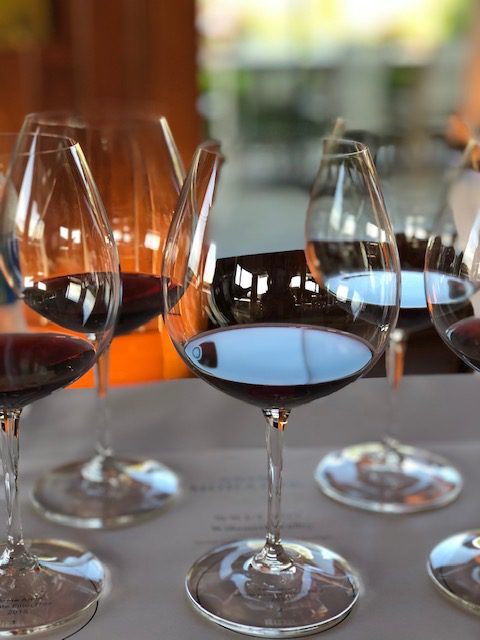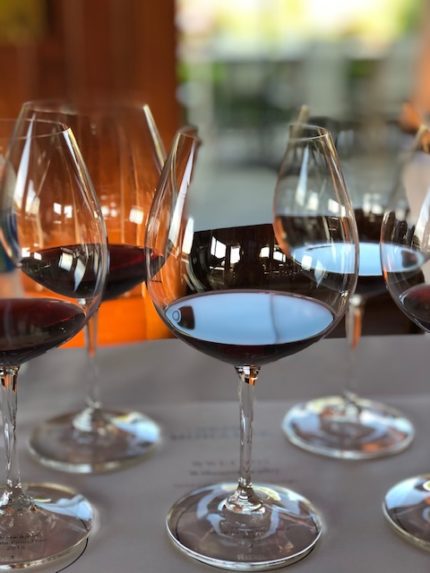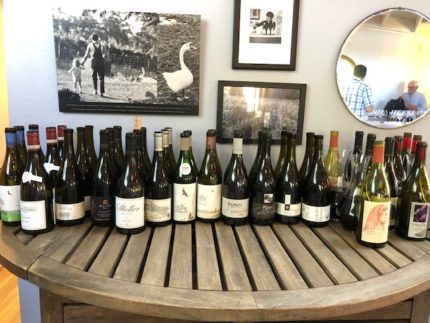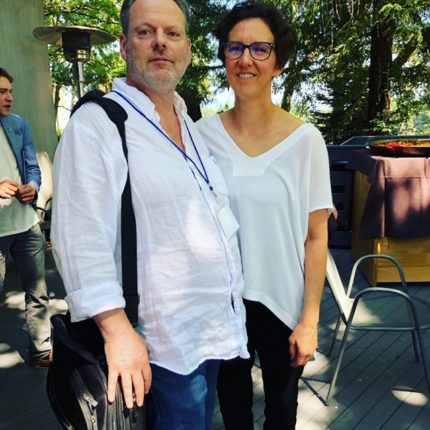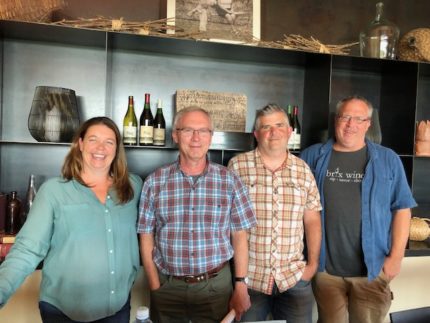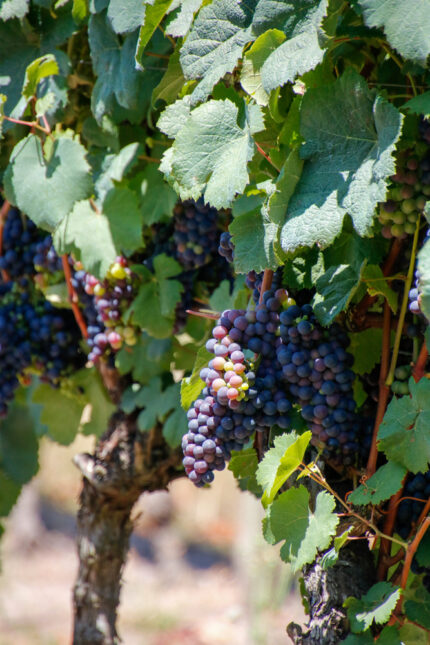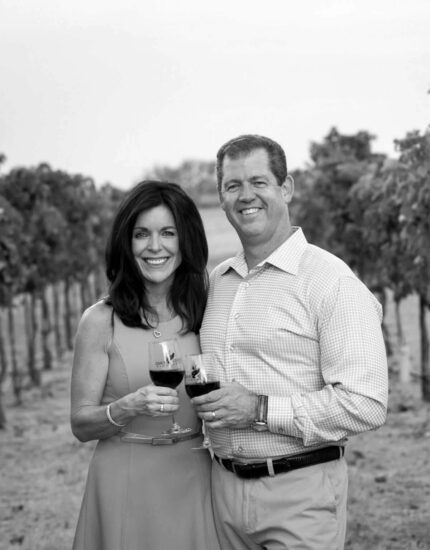The Willamette Valley is a region that is planted with 80 percent Pinot Noir grapes and because of that, it’s very easy to have the misconception that Oregon Pinot Noirs are similar in nature. But once you factor in AVAs, clones, soils, temperatures and the seven regions, you’ll find that while the Willamette is recognized as one of the premier Pinot Noir producing areas in the world, that statement could not be more misleading.
Fred Swan, Conference Organizer and Wine Educator, with Elaine Brown at the WWET Conference
And who better to illustrate those differences than Elaine Brown, American Specialist at JancisRobinson.com, a contributing writer with Wine & Spirits Magazine, and one heck of an entertaining speaker at events worldwide. Elaine walked us through 24 glasses of Pinot Noir, and we uncovered the differences AVA by AVA.
Associate Winemaker Robin Hawsey from Sokol Blosser; VP of Winemaking Melissa Burr of Stoller Family Estate; Winemaker Aaron Bell of Domaine Drouhin Oregon, Winemaker Sean Davis of Beacon Hill Wines, Winemaker Jason Lett of The Eyrie Vineyards and Winemaker Jacques Tardy of Torii Mor
Having a little fun in the midst of the overwhelming “pose here, look here, I’m taking a picture here” requests
Dundee Hills AVA
Described as an “upside-down fist,” this AVA was first planted in 1966 and became official in 2005. This AVA, approximately 28 miles southwest of Portland, stands in the shadow of Mount Hood and is 6,940 acres in total size. It was planted with 1,300 acres of grapes.
I tasted lots of red fruit and spice. I could see an ability to age these wines.
We also had a chance to spend time with Winemakers Jason Lett from The Eyrie Vineyards, Arron Bell from Domaine Drouhin, Robin Hawley (Associate Winemaker), Sokol Blosser, Sean Davis from Beacon Hill, Melissa Burr from Stoller and Jacques Tardy from Torii Mor with additional glasses of wine.
Burr said, “this is a region that has a sense of transparency in winemaking. There is such a sense of place.”
Winemaker Ariel Eberle from Yamhill Valley Vineyards; Winemaker Wayne Bailey from Youngberg Hill; Winemaker Brianne Day from Day Wines; Winemaker Scott Neal from Coeur de Terre and Winemaker Anne Sery from Hyland Estates
McMinnville AVA
Described as an “upside-down elephant,” this AVA is 39,000 acres and is located near the town of McMinnville. Established in 2005, the 39,000 acre area is located near the Coast Range foothills and is cooler because of the rain and fog influence and closeness to the Van Duzer Corridor.
These Pinots had power and concentration.
We sat down with Winemakers Wayne Bailey from Youngberg Hill, Ariel Eberle with Yamhill Valley Vineyards, Brianne Day of Day Wines, Scott Neal of Coeur de Terre and Anne Sery of Hyland Estates.
Sevy talked about how these wines have higher acidity, depth, intensity and are more savory due to the region.
Thomas Housman, Winemaker, Anne Amie Wines; James Frey, Proprietor, Trisaetum Winery; Shane Moore, Winemaker, Gran Moraine, Eugenia Keegan, GM of Jackson Family Oregon and representing Willakenzie Wine and Steve Lutz, Winemaker of Lenné Estate
Yamhill-Carlton AVA
Described as an “upside-down horseshoe,” this 60,000 square-foot AVA is north of McMinnville located near the foothills of the Coast Range and has some of the oldest vines in Willamette. It was established in 2005 and doesn’t have direct impact by the weather but gets fog and breezes. The soils are sedimentary with decomposed sandstone and shallow soil.
Willamette Valley Pinot Noir
The Pinot Noirs had lots of black fruit and tannins with lower acidity.
We later had a session where we tasted five additional Pinot Noirs from Winemakers Thomas Housman from Annie Amie Vineyards, James Frey from Trisaetum, Shane Moore from Gran Moraine, Eugenia Keegan (GM) from WillaKenize and Steve Lutz from Lenné Estate.
Willamette Valley Pinot Noir
Frey talked about the Yamhill-Carlton AVA as having a sense of place in wine. He compared his love of painting to his love of making wine. “When I paint, I start with color and see what evolves. It’s the same with wine. It comes from the heart, and I respond to what Mother Nature gives me and evolve my style accordingly.”
Winemaker Luisa Ponzi, Ponzi Vineyards; Tom Mortimer, Proprietor, LaCadeau; Stephen Goff, Winemaker, Colene Clemens and Jim Anderson, Winemaker, Patricia Green
Chehalem Mountains AVA
Described as an “upside-down dinosaur (think a T-Rex who has fallen and can’t get up),” this AVA was established in 2006 and is a single landmass made up of several hilltops and ridges that are the highest point of elevation at Bald Peak. This AVA also has the largest variation of temperatures that can result in a three week difference in ripening the same Pinot Noir grapes.
The Pinot Noirs are known for being dark and rich.
Ribbon Ridge AVA
No fun descriptor here except “difficult” due to its tough weather and difficult growing conditions. It was first planted in 1982, and it’s the smallest AVA and is only three miles wide. It was established in 2005, and today there are 500 acres planted.
The Pinots have no particular style due to the diversity of so many microclimates, soils and elevations. It was a fun discovery progress.
We were able to sit down with Winemakers Luisa Ponzi from Ponzi Vineyards, (Proprietor) Tom Mortimer from Le Cadeau, Stephen Goff from Colene Clemens and Jim Anderson from Patricia Green who covered both AVAs in Pinot tasting.
Goff summed up the description of the AVAs perfectly,” these AVAs are a work in progress. We have different soils, climates, elevations. It is the last bastion of understanding what makes Oregon special and I really hope we stay integrated (note – there is discussion about further segmenting this AVA).”
Winemaker Thomas Savre, Lingua Franca Wines; Winemaker Ben Casteel from Bethel Heights Vineyard; Winemaker Shane Moore from Zena Crown Vineyard and Farmer and Artist Claire Carver at Big Table Farm (front)
Eola-Amity Hills AVA
Described as “an upside-down seahorse,” the Eola-Amity AVA, which was established in 2006, is located near the Van Duzer Corridor, which results in a 10 degree temperature drop at night and greater clonal variation.
I tasted lots of aromatics and spice in these Pinots.
We were joined by Winemaker Ben Casteel from Bethel Heights, Thomas Savre from Lingua Franca, (Farmer and Artist) Clare Carver and Shane Moore from Zena Crown.
Carver talked about the richness of this AVA. “This AVA has shape that makes the wines richer, almost all encompassing. They are weighty and have their own sense of place.”
Van Duzer Corridor AVA
Described as a “grilled cheese sandwich,” this is the newest AVA, established in 2019. While the AVA is 60,000 in total, only 1,000 acres are planted. This is the coolest place in the valley and has the most wind exposure. There are only six wineries located in this AVA, but many more vineyards than that.
I tasted lots of exotic flavors and spices in these Pinots as well as some intensity.
Don’t think that this region is one of Pinot Noir only. Because any Fred Swan conference shows the diversity of the region, we had wines that we never unexpected. From Sparkling Wine to Chardonnay to Pinot Gris to Rosé to Arneis to Dolcetto to Pinot Meunier to Cabernet Franc to Syrah Noir to Tempranillo to Riesling to Pinot Gouge to Pinot Blanc to Gamay, the Willamette Valley is a exploration in tastes, style and discovery.
